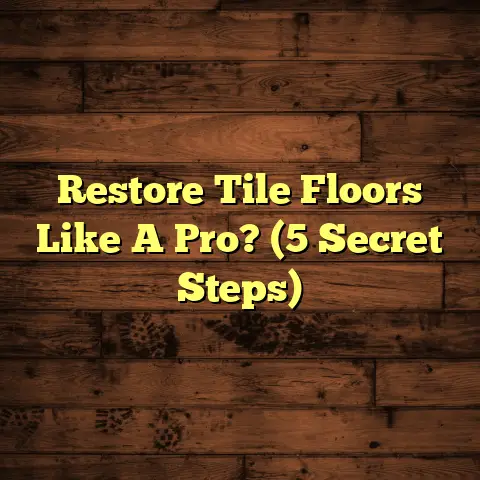Reduce Echo In Hardwood Room (Quick Sound Fix!)
That’s the dreaded echo, and trust me, as a flooring contractor, I’ve seen it in countless homes.
It’s not just annoying; it can make conversations difficult, ruin your movie nights, and generally make a space feel less comfortable.
But don’t worry, you don’t need to tear down walls or spend a fortune to fix it!
In this article, I’m going to share some simple, quick fixes to reduce echo in your hardwood-floored room.
These are solutions I’ve recommended to clients over the years, and they really work.
Let’s dive in and get your space sounding great!
I. Understanding Echo
Okay, so what exactly is echo?
It’s different from reverberation, which is a more general “wash” of sound.
Echo is a distinct repetition of a sound.
Think of shouting in a canyon – that’s echo in its purest form.
In a room, it happens when sound waves bounce off hard, flat surfaces like your hardwood floors and walls.
The physics behind it is pretty straightforward:
Sound travels in waves, and when those waves hit a hard surface, they reflect.
The smoother and harder the surface, the more sound is reflected.
Hardwood, being dense and smooth, is a prime culprit.
Room shape and size also play a big role.
A large, empty room with parallel walls is an echo chamber waiting to happen.
Think about it:
The sound has plenty of space to travel and bounce around before it eventually dissipates.
Even the lack of furniture contributes!
Empty spaces mean fewer things to absorb sound waves.
I’ve seen this time and again.
A newly renovated house with beautiful, bare hardwood floors often sounds terrible until the owners move in their furniture.
Let’s say you’re trying to have a conversation in an echoey room.
You speak, and your voice bounces off the walls, creating a delayed repetition.
It can be hard to understand what someone is saying because their words are competing with their own echoes!
Or imagine trying to enjoy your favorite music.
The echo muddies the sound, making it less clear and enjoyable.
Even watching TV can be a pain, with dialogue getting lost in the echoes.
It’s distracting, fatiguing, and completely undermines the enjoyment of your space.
II. Assessing Your Space
Before we start fixing things, let’s figure out just how bad your echo problem is.
Here’s a simple test:
Clap your hands loudly in different parts of the room.
Do you hear a clear echo, or just a general reverberation?
If you hear a distinct repetition of the sound, you’ve got an echo problem.
You can also use a smartphone sound meter app.
There are plenty of free ones available.
These apps measure sound levels, and some can even analyze the frequency and duration of echoes.
While not super precise, they can give you a general idea of the sound quality in your room.
Walk around the room and take measurements in different spots.
Where is the echo most pronounced?
Is it near the center of the room, or closer to the walls?
Pay attention to the features in your room.
Are there large, bare walls?
Is the room sparsely furnished?
Are there a lot of hard surfaces, like glass or metal?
These are all potential contributors to the echo problem.
I once worked on a house where the homeowner swore their new hardwood floors were defective because of the echo.
But after doing a thorough assessment, we realized the problem wasn’t the floors themselves, but the fact that the room was completely empty!
No rugs, no curtains, no furniture – just bare walls and floors.
Once they started adding soft furnishings, the echo disappeared.
III. Quick Fixes to Reduce Echo
Alright, let’s get to the good stuff: the solutions!
These are the quick fixes I’ve found to be most effective for reducing echo in hardwood-floored rooms.
We’ll break it down into four categories:
- Soft Furnishings
- Wall Treatments
- Furniture Arrangement
- Additional Accessories
A. Soft Furnishings
This is often the easiest and most effective way to reduce echo.
Soft materials absorb sound waves, preventing them from bouncing around the room.
Rugs:
A large area rug can make a huge difference.
Look for rugs with a thick pile, as these will absorb more sound.
Wool rugs are particularly good for sound absorption.
Here’s a table showing the sound absorption coefficients of different rug materials:
| Material | Sound Absorption Coefficient (at 500 Hz) |
|---|---|
| Wool | 0.30 – 0.50 |
| Nylon | 0.20 – 0.40 |
| Cotton | 0.15 – 0.30 |
| Synthetic | 0.10 – 0.25 |
Source: Acoustic Sciences
As you can see, wool is a clear winner in terms of sound absorption.
But even a synthetic rug is better than nothing.
Place the rug in the center of the room, or wherever the echo is most pronounced.
Curtains:
Heavy curtains can also do wonders for sound absorption.
Choose curtains made from thick, sound-absorbing materials like velvet, suede, or even lined cotton.
Hang them as close to the wall as possible, and make sure they extend to the floor.
The more fabric you have, the more sound they’ll absorb.
Cushions and Throw Pillows:
Don’t underestimate the power of cushions and throw pillows!
They may seem small, but they can add up to a significant amount of sound absorption.
Scatter them around your sofas, chairs, and even on the floor.
Choose cushions with different textures and fillings for maximum sound absorption.
DIY Options:
You don’t have to spend a fortune on soft furnishings.
There are plenty of DIY options you can try.
-
Upholstered Furniture: If you’re handy with tools, you can try upholstering an old chair or ottoman with a sound-absorbing fabric.
-
Wall Hangings: Create your own wall hangings using fabric scraps, blankets, or even old quilts.
-
Fabric-Wrapped Panels: Wrap pieces of plywood with fabric and hang them on the walls.
Here’s a tip:
When choosing materials, think about both sound absorption and aesthetics.
You want your soft furnishings to look good and sound good!
Choose colors and patterns that complement your existing décor, and don’t be afraid to experiment.
I once helped a client create a stunning wall hanging using recycled fabric scraps.
It not only looked beautiful but also significantly reduced the echo in their living room.
B. Wall Treatments
Just like soft furnishings, wall treatments can absorb sound and reduce echo.
Wall Hangings:
Tapestries, large paintings, and even framed fabric can all help to absorb sound.
Choose pieces that are large and have a textured surface.
The more surface area they cover, the more sound they’ll absorb.
Acoustic Panels:
These are specifically designed to absorb sound.
They come in a variety of shapes, sizes, and colors, so you can find ones that match your décor.
Acoustic panels are often made from fiberglass or mineral wool, which are highly effective at absorbing sound.
They can be a bit pricey, but they’re a great option if you’re serious about reducing echo.
Fabric Walls:
This is a more advanced option, but it can be very effective.
You can cover your walls with fabric to create a soft, sound-absorbing surface.
There are several ways to do this:
-
Staple Fabric to the Wall: This is the easiest method, but it can damage your walls.
-
Use Fabric Panels: Create fabric panels and attach them to the wall with adhesive or hooks.
-
Hire a Professional: If you’re not comfortable doing it yourself, you can hire a professional to install fabric walls.
Step-by-Step Instructions for Hanging Items:
- Choose Your Wall Hanging: Select a tapestry, painting, or fabric panel that you want to hang.
- Measure and Mark: Measure the space where you want to hang the item and mark the location of the hooks or nails.
- Install Hooks or Nails: Install hooks or nails at the marked locations.
- Hang the Item: Carefully hang the item on the hooks or nails.
Step-by-Step Instructions for Applying Fabric to Walls:
- Choose Your Fabric: Select a fabric that is thick and sound-absorbing.
- Measure and Cut: Measure the wall and cut the fabric to the appropriate size.
- Attach the Fabric: Use staples, adhesive, or hooks to attach the fabric to the wall.
- Smooth Out Wrinkles: Smooth out any wrinkles or bubbles in the fabric.
Remember, the goal is to create a surface that absorbs sound waves.
The more surface area you cover, the more effective the wall treatment will be.
I once helped a client transform their home office by covering one wall with a large tapestry.
It not only added a touch of elegance to the room but also significantly reduced the echo, making it a much more pleasant workspace.
C. Furniture Arrangement
Believe it or not, the way you arrange your furniture can also affect the sound quality in your room.
Breaking Up Sound Waves:
The key is to break up the sound waves and prevent them from bouncing around the room.
You can do this by strategically placing furniture to create obstacles in the path of the sound waves.
Bookshelves:
A large bookshelf filled with books can act as a natural sound barrier.
The books absorb sound waves, preventing them from reflecting off the wall behind the bookshelf.
Sofas and Chairs:
Place sofas and chairs against the walls to absorb sound waves.
Angle them slightly to break up the sound waves even further.
Using Larger Pieces of Furniture as Sound Barriers:
Large pieces of furniture, like armoires or entertainment centers, can be used as sound barriers to divide the room and prevent sound waves from traveling freely.
Place them strategically to block the path of sound waves and reduce echo.
Incorporating Multi-Functional Furniture:
Multi-functional furniture, like storage ottomans or sofa beds, can serve both a practical and a sound-absorbing purpose.
Use them to store blankets, pillows, or other soft items that can absorb sound.
Here’s a tip:
Think about the flow of sound in your room.
Where does the sound originate, and where does it travel?
Arrange your furniture to disrupt that flow and prevent sound waves from bouncing around.
I once helped a client rearrange their living room to reduce echo.
We moved the sofa away from the wall and angled it slightly, and we placed a large bookshelf against the opposite wall.
The result was a much more comfortable and sound-friendly environment.
D. Additional Accessories
In addition to soft furnishings, wall treatments, and furniture arrangement, there are a few other accessories you can use to reduce echo.
Foam Panels:
These are specifically designed to absorb sound.
They come in a variety of shapes, sizes, and colors, and they can be easily attached to walls or ceilings.
Foam panels are a great option for home theaters, recording studios, or any room where sound quality is critical.
Soundproof Curtains:
These are designed to block out sound from the outside, but they can also help to absorb sound from the inside.
Soundproof curtains are made from thick, heavy materials that are effective at blocking sound waves.
Acoustic Tiles:
These are similar to foam panels, but they are typically made from different materials, like cork or recycled plastic.
Acoustic tiles can be used on walls, ceilings, or even floors to absorb sound.
Choosing and Installing These Products Effectively:
When choosing sound-absorbing accessories, consider the size of your room, the severity of the echo problem, and your budget.
Start with the most affordable and easiest-to-install options, like foam panels or soundproof curtains.
If those don’t provide enough sound absorption, you can move on to more expensive and complex options, like acoustic tiles.
Options for Renters vs. Homeowners:
If you’re a renter, you may not be able to make permanent changes to your walls or ceilings.
In that case, focus on portable and removable options, like foam panels with adhesive backing or soundproof curtains that can be hung with tension rods.
If you’re a homeowner, you have more options.
You can install acoustic tiles, fabric walls, or even build a dedicated home theater with soundproofing materials.
Combining Different Materials and Products:
For maximum sound absorption, try combining different materials and products.
For example, you could use a combination of rugs, curtains, wall hangings, and foam panels to create a sound-dampening environment.
Experiment with different combinations to find what works best for your space.
I once helped a client transform their basement into a home theater.
We used a combination of foam panels, soundproof curtains, and acoustic tiles to create a room that was virtually soundproof.
The result was a truly immersive movie-watching experience.
IV. Conclusion
So there you have it: a comprehensive guide to reducing echo in your hardwood-floored room.
We’ve covered everything from understanding echo to assessing your space to implementing quick fixes.
Remember, a comfortable sound environment is essential for a happy and healthy home.
Echo can be distracting, annoying, and even detrimental to your well-being.
By implementing the simple fixes I’ve outlined in this article, you can create a space that is both beautiful and acoustically pleasing.
Don’t be afraid to experiment and try different solutions until you find what works best for your space.
Start with the easiest and most affordable options, and gradually work your way up to more complex solutions if needed.
And most importantly, don’t give up!
With a little effort, you can transform your echoey room into a comfortable and inviting space.
So go ahead, take action, and start enjoying your new sound-friendly environment!





